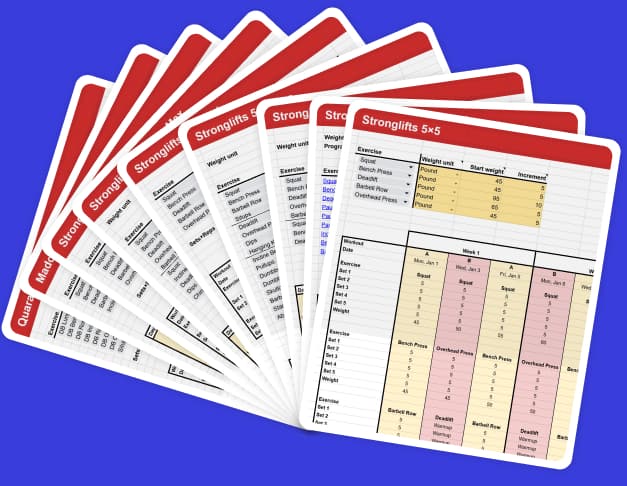General Madcow 5×5 questions
Why does Madcow 5×5 work?
The Madcow 5×5 program works because it focuses on fundamental training principles:
- Progressive overload: you add weight over time. This stimulates your body to get stronger and build muscle.
- Compounds: you Squat, Bench, Deadlift, Row. These lifts work several muscles at the same time.
- Technique: you Squat 3x and Bench 2-3x/week. You get lots of practice to improve your form.
- Consistency: only three exercises 3x/week. Madcow 5×5 takes little time. It’s easy to stick to.
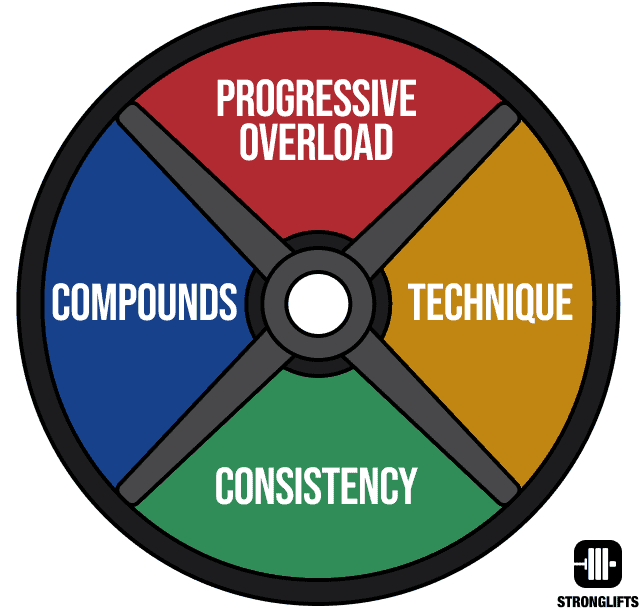
These basic training principles always work for drug-free lifters. That’s why Madcow 5×5 works so well for gaining strength and muscle.
Take a look at the results people have achieved on Madcow 5×5.
Contents
Join the Stronglifts community to get free access to all the spreadsheets for every Stronglifts program. You’ll also get daily email tips to stay motivated. Enter your email below to sign up today for free.
Does Madcow 5×5 build muscle?
Yes, Madcow 5×5 builds muscle.
- Sets of five reps build muscle. Studies show that low reps build as much muscle as higher reps (1, 2, 3, 4).
- Routines with only compound exercises like Squat and Bench build just as much muscle as routines with only isolation exercises (5).
- Your arms don’t stay small if you only do compound exercises like Bench and Rows. They grow in size (6, 7, 8, 9).
- Progressive overload – adding weight over time – makes your body grow muscle to lift heavier weights. Progressive overload is the fundamental principle of training (10). Muscular tension is key for building muscle (11, 12).
Strength is size. Your legs will be bigger when you Squat 300lb than 150lb. Your chest will be bigger when you Bench 200lb than 100lb. Your back will be bigger when you Deadlift 400lb than 200lb.

The Madcow 5×5 program started on bodybuilding forums. Madcow was tired of lifters doing high rep isolation pump routines like the pros. He created Madcow 5×5 for drug-free lifters looking to build muscle. The program just happens to build strength too.
Is Madcow 5×5 good for beginners?
No. Madcow 5×5 can work for beginners, but progress will be slow. The weight only increases once a week. Most beginners can add weight every workout. They can progress faster on Stronglifts 5×5.
Compare starting both programs with 95lb on the Squat. After 10 weeks, you could be Squatting 65lb more with Stronglifts 5×5.
| Program | Start | 10 weeks | Gain |
|---|---|---|---|
| Madcow 5x5 | 95lb | 140lb | +55lb |
| Stronglifts 5x5 | 95lb | 225lb | +130lb |
Progress on Stronglifts 5×5 is faster because you add weight every workout, 3x/week. Beginners can do this because they can’t lift much weight yet (despite sometimes going to the gym for years).
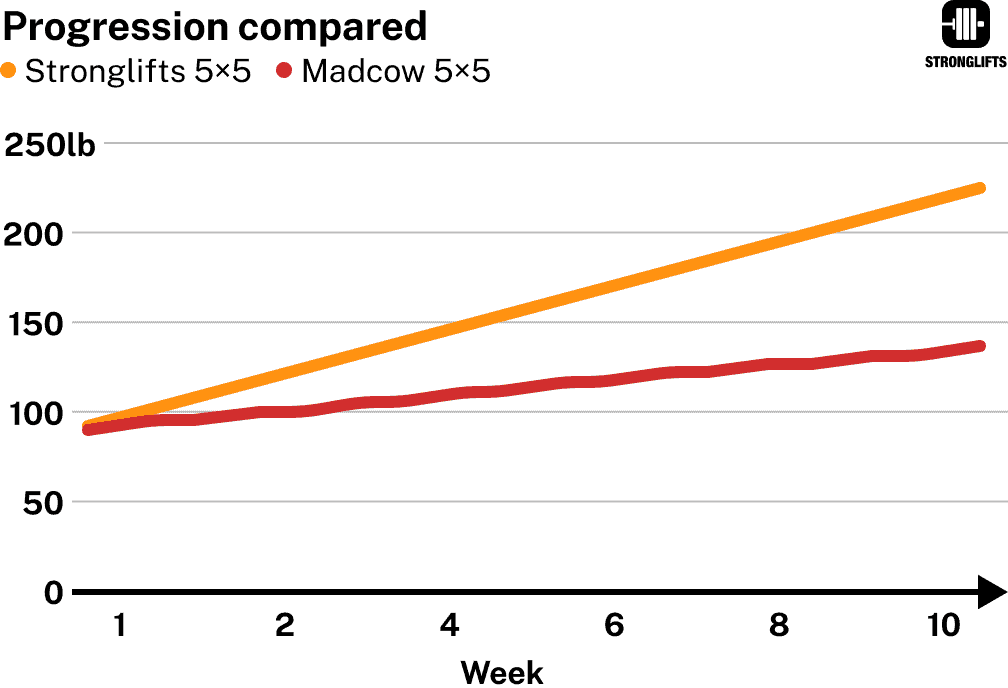
Madcow 5×5 doesn’t add weight each workout. It adds weight once a week. Each week you try to Squat more weight in workouts A and C than you did in last week’s workouts A and C. Madcow 5×5 adds 5lb/week on the Squat. Stronglifts 5×5 adds 15lb/week.
Why not do Stronglifts 5×5 forever then? Because you can’t add weight every workout forever. Otherwise everyone would be Squatting 1000lb. Strength gains follow the law of diminishing returns (13). The stronger you get, the harder it is to get even stronger.
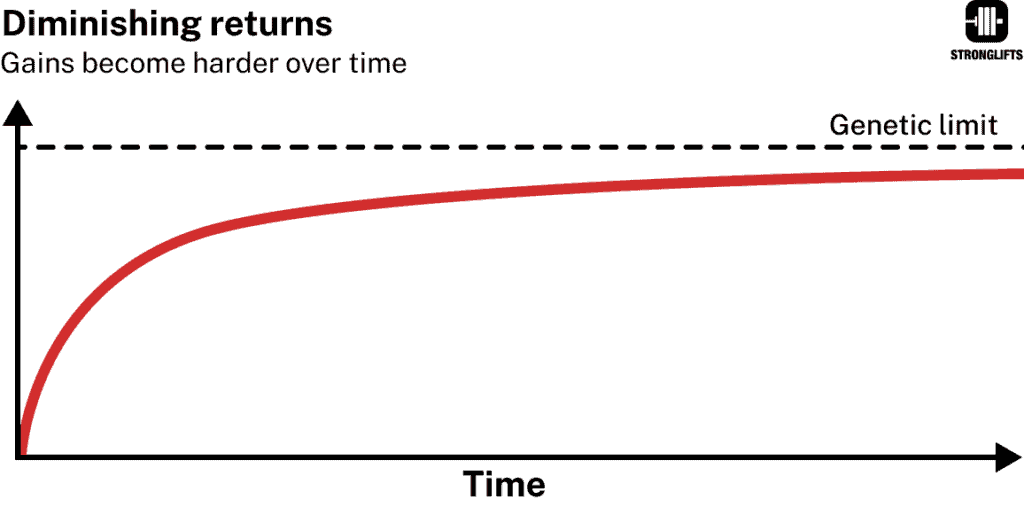
This means you should start by adding weight every workout. You can do that on Stronglifts 5×5 if you’re not that strong yet. Once you can no longer add weight each workout, switch to Madcow 5×5.
Madcow 5×5 is not a program for beginners. It’s for lifters who are no longer beginners. You should have experience doing Squats, Bench and Deadlift. If you don’t, do Stronglifts 5×5 for a few weeks first.
Who should do Madcow 5×5?
Madcow 5×5 is a good program for experienced lifters.
- You have good form and strength on Squat, Bench and Deadlift.
- You want to alternate heavier and lighter workouts.
- You want a simple program that’s easy to follow.
- You want to lift 3x/week for about an hour.
- You want to gain strength and size.
You can switch to Madcow 5×5 once you’re no longer making progress on Stronglifts 5×5. The programs are similar which makes the transition easy. Madcow 5×5 adds variety for continued progress.
If you lack experience doing Squats, Bench and Deadlifts or are new to lifting, start with Stronglifts 5×5. You’ll build basic strength and size while improving your form. After a few weeks you’ll get stuck. Move to Madcow 5×5 so you can continue gaining strength and size.
How does Madcow 5×5 work?
Madcow 5×5 uses heavy light medium workouts with a double progression.
- You alternate heavy, light and medium workouts. This gives you plenty of recovery to get stronger.
- You alternate adding weight with adding reps. You try to lift more weight than you did last week.
- You do compound exercises like Squats, Bench, Deadlifts and Rows. You alternate sets of five, three and eight reps.
Notice how your Squat volume goes up and down during the week. This is because Madcow 5×5 alternates heavy, light and medium workouts. You’re not doing heavy Squats each workout.
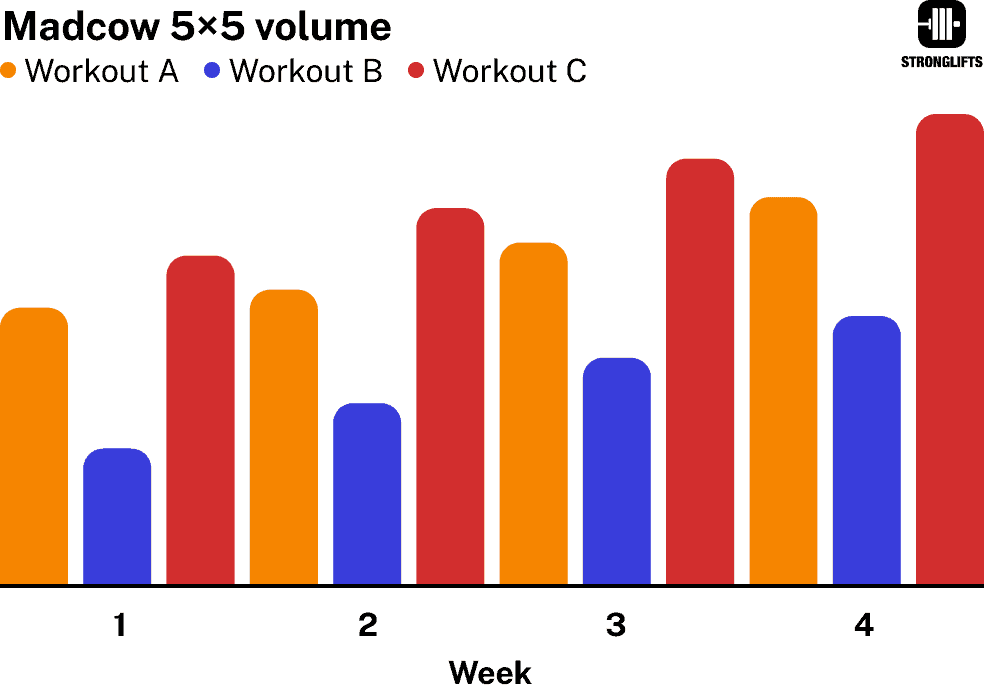
For more info, read heavy light medium explained and Madcow 5×5’s double progression.
Does Madcow 5×5 alternate workouts?
No. On Madcow 5×5 you do workout A/B/C every week.
You don’t alternate A/B/A with B/A/B like on Stronglifts 5×5. Madcow 5×5 uses a heavy light medium system. That requires three different workouts. This is your weekly schedule on Madcow 5×5…
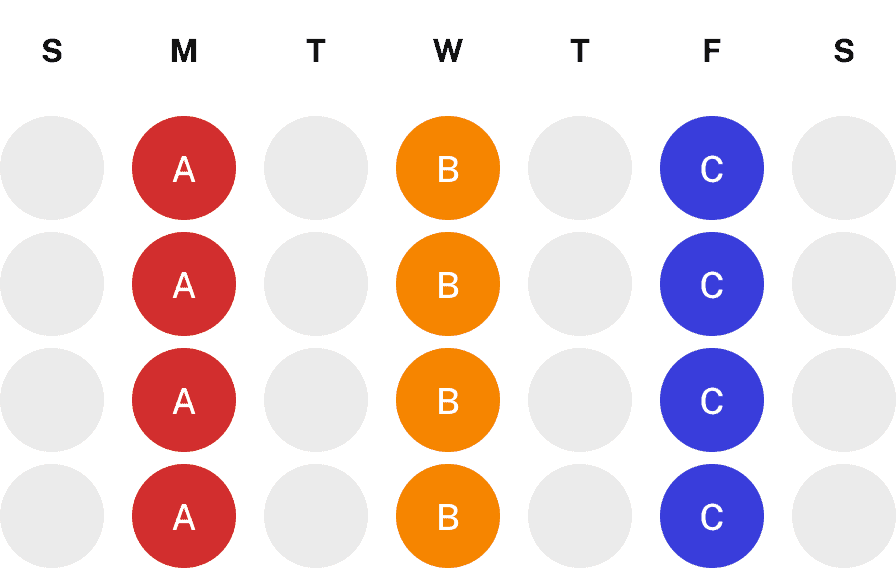
Here’s how often you do each exercise on Madcow 5×5…
- Squat 3x/week (1x heavy, 1x light, 1x medium)
- Bench/Row 2x/week (1x heavy, 1x medium)
- Deadlift/Overhead Press 1x/week (heavy).
If you Incline Bench in workout B instead of doing Overhead Press, you Bench Press 3x/week (1x heavy, 1x light incline, 1x medium).
Madcow 5×5 exercise questions
What are the main exercises in Madcow 5×5?
On Madcow 5×5 you do compound exercises in all three workouts:
- Workout A: Squat, Bench Press, Barbell Row
- Workout B: Squat, Incline Bench (or Overhead Press), Deadlift
- Workout C: Squat, Bench Press, Barbell Row
Madcow 5×5 has optional assistance work like chinups, dips, biceps curls and skullcrushers.
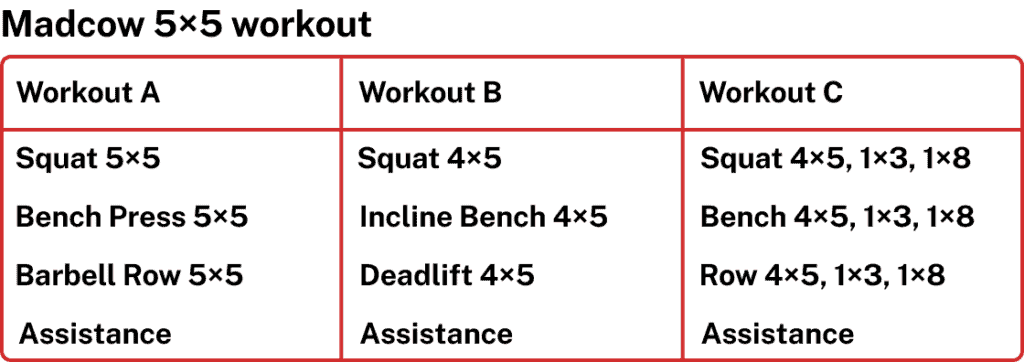
Should you do Incline Bench Press or Overhead Press in Madcow 5×5 workout B?
Both exercises are great.
- Incline Bench works your upper chest and shoulders a little more than flat bench (14). It can also improve your Bench form by teaching you to press the bar back on the way up (15).
- Overhead Press works your shoulders more than Incline Bench Press. Some lifters (like me) find that their shoulders feel better if they Overhead Press 1x/week vs bench all the time.
The original Madcow 5×5 program had Incline Bench in workout B. Many Stronglifters didn’t like to lose the Overhead Press after they switched from Stronglifts 5×5. That’s why I added a Madcow 5×5 version with the Overhead Press in workout B.
Other Stronglifters are happy to no longer Overhead Press. It’s one of the hardest big lifts to progress on because it uses small muscles. They’re happy to Incline Bench for a while and work chest more.
Pick what looks more interesting to you. Say you’d like to try something new. Pick Incline Bench. Next time you do Madcow 5×5, do Overhead Press instead. This way you can test what works better for you.
Starting Madcow 5×5 questions
How to start doing Madcow 5×5?
- Enter your five rep max in the Stronglifts app or Madcow spreadsheet.
- We’ll generate your workouts for the next 12 weeks. You’ll know which exercises to do each day and for how many sets.
- We’ll also calculate your starting weights. You’ll know what weights to use on each set.
- Just follow what the app or spreadsheet gives you, and start getting results.
When should you switch from Stronglifts 5×5 to Madcow 5×5?
Switch to Madcow 5×5 when you’re no longer making progress on Stronglifts 5×5. If your Squat has been stuck at the same weight for weeks or you’re bored of Stronglifts 5×5, move to Madcow 5×5.
Some Stronglifters struggle to move away from Stronglifts 5×5. The program helped them become consistent at going to the gym. It helped them improve their form. It made them bigger and stronger. They have a simple routine that has worked so far. They don’t want to give all that up. Or they’re too busy to think about a different program right now.
The problem is that no program works forever. What works to increase your Squat from 0 to 200lb isn’t always going to work to get it from 200 to 300lb. You’re not the same person as when you started. You’re bigger, stronger, more skilled. The same thing isn’t going to keep working.
Madcow 5×5 progression questions
Should you progress by adding weight or a percentage?
Progress by adding weight on Madcow 5×5. This is simpler as I’m going to show you. Madcow said to progress by adding 2.5% per week. But it makes little difference compared to adding 2.5 to 5lb per week.
Let’s look at progressing by adding 2.5% per week first.
| Weight | +2.5% | Increase |
|---|---|---|
| 100 | 102.5 | +2.5lb |
| 200 | 205 | +5lb |
| 300 | 307.5 | +7.5lb |
| 400 | 410 | +10lb |
| 500 | 512.5 | +12.5lb |
Notice how you’re adding less weight if you lift less weight. Which you will on exercises that work smaller muscles like the Bench and OHP. Percentages force microloading which improves progress.
But there are several drawbacks to using a weekly percentage increase on Madcow 5×5 (please note that I’m not against using percentages in other programs, what follows is about Madcow only).
First drawback: the more weight you lift, the more weight you add when you progress using a percentage.
- If you Overhead Press 100lb, 2.5% more is 102.5lb. Microloading is better for lifts that work smaller muscles.
- Once you Overhead Press 150lb, 2.5% more is 153.75lb. Are you really going to round that to 155lb vs doing 152.5lb?
It gets worse. Say you pull 440lb for five. 2.5% more is 450lb. Adding 10lb/week is too big of a jump. I’d add 5lb or 1.25%. Why? Stronger lifters progress more slowly than weaker lifters (13).

Adding 2.5% per week makes you take bigger weight jumps as you get stronger. Yet the stronger you get, the harder it is to get even stronger. That’s why taking smaller jumps make more sense, especially on lifts that work smaller muscles like the Bench and Overhead Press.
Second drawback: the added weight changes over time. At 100lb it’s 2.5lb, at 200lb it’s 5lb, at 300lb it’s 7.5lb. If we had built this algorithm in the Stronglifts app, many people would think it’s a bug (“The weight suddenly increased by 7.5lb instead of 5lb. Is this a bug?!?”).
Third drawback: adding a percentage is harder math. Which one is easier? 220lb + 5lb or 220lb x 2.5%? Adding 5lb is easier math. It also saves you extra math rounding the weight (220lb x 2.5% == 225.5 – this needs to be rounded to 225 to match your plates).
Finally, when lifting around 200lb, there’s no difference between adding 2.5% or 5lb. You will add the same weight on the bar.
| Weight | +2.5% | +5lb | Difference |
|---|---|---|---|
| 200 | 205 | 205 | 0 |
| 205 | 210.1 | 210 | 0.1 |
| 210 | 215.3 | 215 | 0.3 |
| 215 | 220.4 | 220 | 0.4 |
| 220 | 225.5 | 225 | 0.5 |
| 225 | 230.6 | 230 | 0.6 |
Keep it simple. Add 5lb on SQ/DL. Add 2.5lb on Bench, Row and OHP. The Stronglifts app uses fixed weight increases for Madcow 5×5. You can change the increments, and use different ones per exercise.
How long should you do Madcow 5×5?
Do Madcow 5×5 as long as you’re making progress. If you can lift more weight or do more reps each week, continue. Madcow 5×5 is not a 12 week program. The spreadsheet shows 12 weeks as an example. If you’re still progressing after 12 weeks, keep doing Madcow 5×5.
How many weeks you will be able to progress on Madcow 5×5 depends on several factors:
- How heavy you started. If you start with a lighter weight, you can progress longer than if you start with a heavier weight.
- How much weight you add. If you add 5lb, or better, 2.5lb/week, you’ll progress longer than if you add 10lb/week.
- Rest between sets. If you rest 4-5min before your top set, you’re less likely to fail sets. You’ll add weight more often.
- How heavy you are. Adding 5lb per week is easier for a 250lb than a 150lb guy. Bigger lifters can lift more weight.
- How close you are to your genetic potential. Stronger lifters typically progress slower than weaker lifters.
Some Stronglifters have made progress on Madcow 5×5 for 20 weeks and longer. Others got stuck after 8-10 weeks. It’s impossible to predict how long you’ll be able to progress on Madcow 5×5. But if you’re not making weekly progress anymore, that’s the end of the program.
You should be able to do Madcow 5×5 for at least four weeks. Your first three weeks should be light. In week four you match your old records. If you can’t progress for four weeks on Madcow 5×5, your starting weights were too heavy or your progression was too aggressive.
When should you stop Madcow 5×5?
Stop Madcow 5×5 if you can no longer lift more weight or do more reps from week to week. If you’re stuck at the same weight, doing the same amount of reps, for 2-3 weeks, then stop the program.
Here are some things you can try to get unstuck…
- Progress by adding less weight. Add 2.5lb/week on the Bench and Overhead Press instead of 5lb/week.
- Resting longer between sets. Rest a good 4-5 min before doing your heaviest set of the day. You’ll get more reps.
- Wear a belt for Squats and Deadlifts. Take a big breath and hold it to increase abdominal pressure. This helps lifting more.
- Use chalk and the mixed grip for Deadlift. This prevents slipping and cancels the bar rotation. It helps lift you more.
What if you’re stuck on Bench but not Squat?
Reset your Bench Press while you continue to progress on Squats.
Say you progress by 2.5lb/week on the Bench Press. You think you can progress for another four weeks on Squats. Lower the Bench weight by 4×2.5lb = 10lb. That gives you 4 weeks of progress on Bench.
You’ll first struggle to progress on exercises that work smaller muscles. Those are the Bench Press, Incline Bench, Overhead Press, and Barbell Row. Smaller muscles lift less weight than bigger muscles.
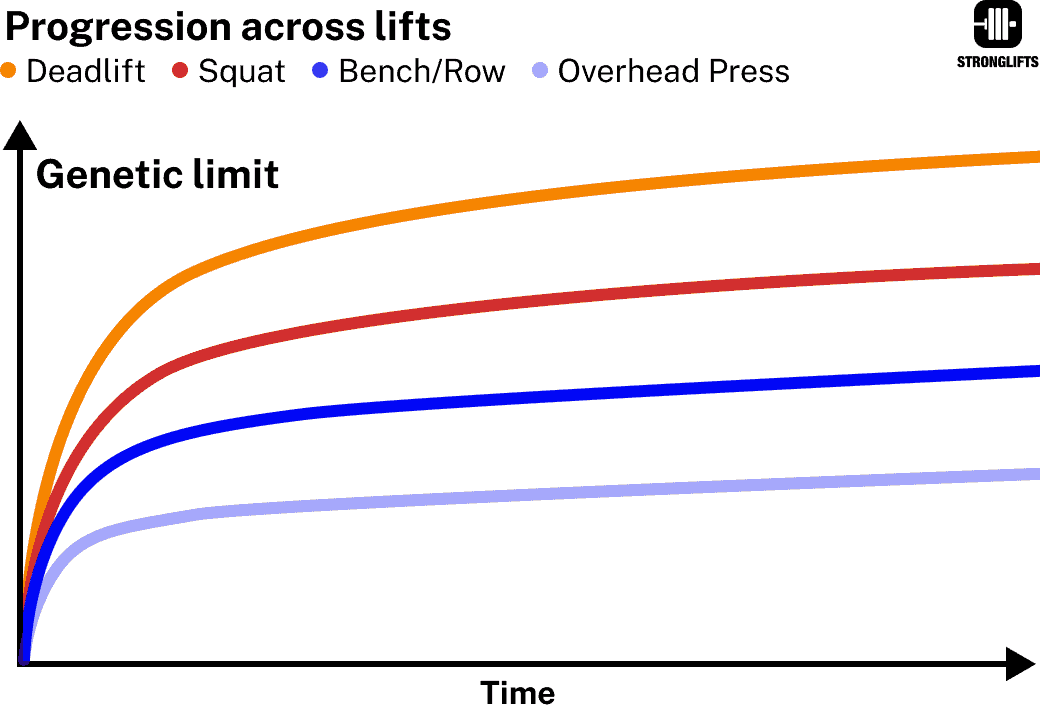
This is why you should use smaller increments of 2.5lb/week on the Bench and Overhead Press. Get a pair of fractional plates so you can add 1.25lb on each side of the bar. You’ll progress better.
What should you do after Madcow 5×5?
If you liked Madcow 5×5, you can do the program again but switch things up. Here’s how:
- Do Front Squat in workout B
- Do Overhead Press in workout B
- Start workout B with Deadlifts
- Squat low bar vs high bar
- Do paused bench vs touch and go
A study by Fonseca et al found that changing exercises was more effective than changing sets and reps for increasing strength (15).
Say you just finished the default Madcow 5×5 program. Like this…
| Workout A | Workout B | Workout C |
|---|---|---|
| Squat 5×5 | Squat 4×5 | Squat 4×5, 1×3, 1×8 |
| Bench 5×5 | Incline Bench 4×5 | Bench 4×5, 1×3, 1×8 |
| Rows 5×5 | Deadlift 4×5 | Rows 4×5, 1×3, 1×8 |
| Assistance | Assistance | Assistance |
You can do Madcow 5×5 again but with slightly different exercises. Here’s an example…
| Workout A | Workout B | Workout C |
|---|---|---|
| Squat 5×5 | Deadlift 4×5 | Squat 4×5, 1×3, 1×8 |
| Bench 5×5 | Overhead Press 4×5 | Bench 4×5, 1×3, 1×8 |
| Rows 5×5 | Front Squat 4×5 | Rows 4×5, 1×3, 1×8 |
You could also add assistance exercises the second time. Maybe you add dumbbell bench and dips to get extra volume for your chest. Maybe you add chinups to get extra work for your back and arms. Like this…
| Workout A | Workout B | Workout C |
|---|---|---|
| Squat 5×5 | Deadlift 4×5 | Squat 4×5, 1×3, 1×8 |
| Bench 5×5 | Overhead Press 4×5 | Bench 4×5, 1×3, 1×8 |
| Rows 5×5 | Front Squat 4×5 | Rows 4×5, 1×3, 1×8 |
| Dips 3×8 | DB Bench 3×8 | Chinups 3×8 |
Or you can do Stronglifts 5×5 Intermediate.
What are the starting weights when doing Madcow 5×5 again?
The first three weeks of Madcow 5×5 should be light and easy. In week four you match your previous records. From week five onwards you try to hit new personal records from week to week.
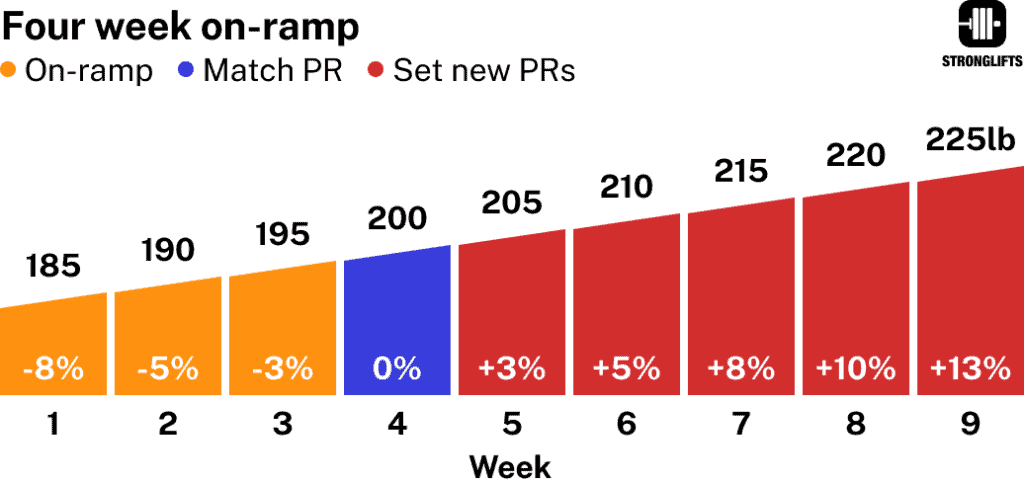
Your starting weights will be higher the second time you do Madcow 5×5. Say you started Squats with 185lb the first time. 12 weeks later you ended Madcow 5×5 with 240lb.
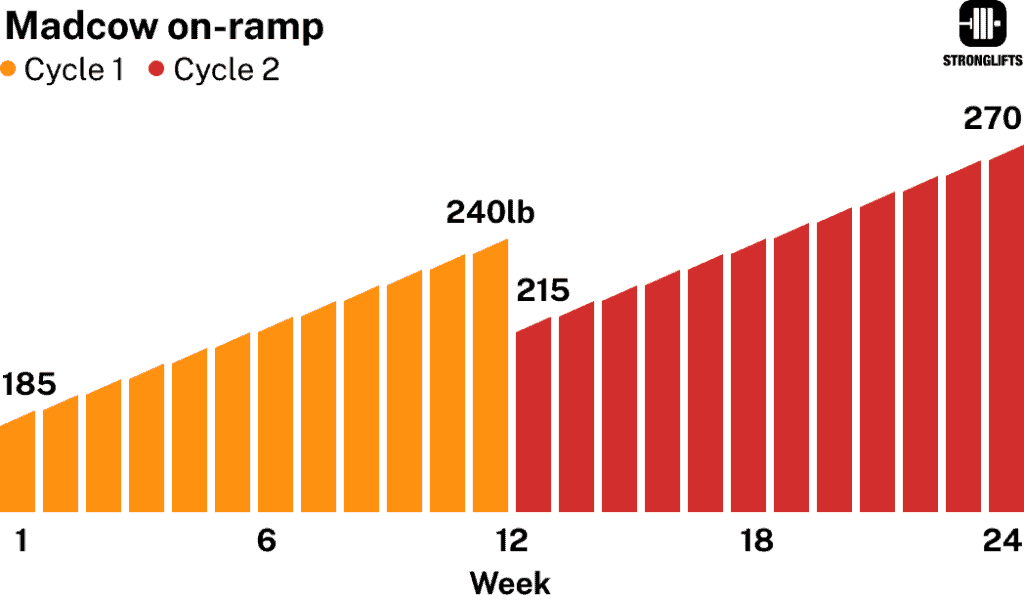
The second time you start Madcow 5×5 with a four week on-ramp. You take four weeks to match your previous record of 225lb. The difference is that your starting weight is higher than the first time.
Many Stronglifters prefer to progress more slowly the second time they do Madcow 5×5. They use a longer on-ramp period of six weeks. The first two weeks are like a deload.
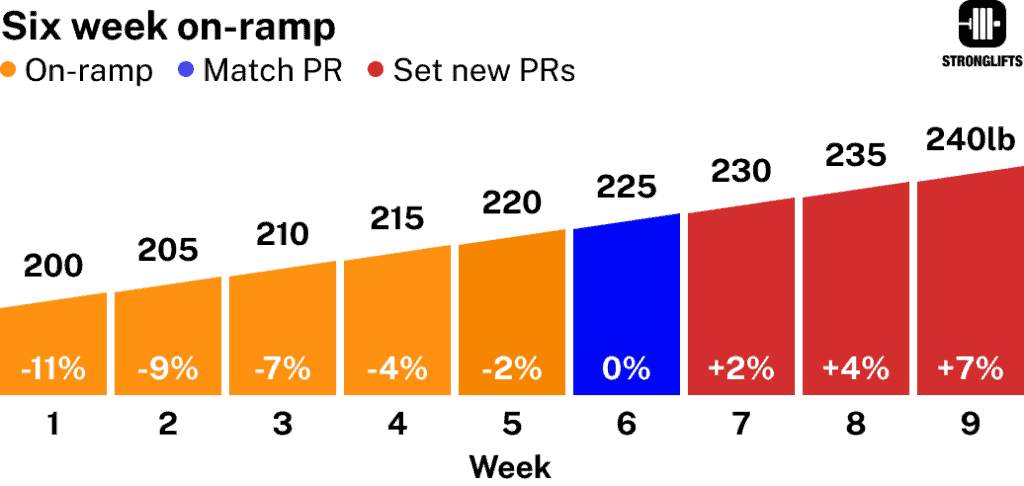
Other Madcow questions
What are the pros and cons of Madcow 5×5?
| Pros Madcow 5x5 | Cons Madcow 5x5 |
|---|---|
| High frequency | No exercise variety |
| Individualizable | Cookie-cutter |
| Effective | Hard work |
Pros of Madcow 5×5
- High frequency. You Squat 3x and Bench 2-3x/week. You get lots of practice to improve your form and get stronger. You alternate hard and easy sessions. You’re not lifting heavy each workout. You get a lot of recovery between hard workouts.
- Individualizable. You can add volume using assistance work and smaller set intervals. You can control the progression using different increments per exercise or longer on-ramps.
- Simple program that’s easy to follow. Enter your best lifts in the Stronglifts app or Madcow 5×5 spreadsheets. We’ll create your workouts, exercises, sets and reps for you. Just follow what the app says and focus on lifting. We’ll do all the thinking for you.
Cons of Madcow 5×5
- No exercise variety. The same five exercises every week. This may seem repetitive but it’s the point of the program. Squatting 3x/week over 12 weeks is 36x vs 12x if Squatting 1x/week. You get 24 more opportunities to improve your Squat technique and get stronger. This is why Madcow 5×5 is so effective.
- Cookie-cutter. Madcow can be individualized but this requires a good understanding of how the program works. Best is to do the default program the first time. You can then use that experience to individualize Madcow 5×5 the second time.
- Hard work. Adding weight each workout and Squatting 3x/week is hard work. Typical mistakes are starting too heavy and adding too much weight. This can result in early plateaus, or worse, aches and pains. You should ease into Madcow 5×5.
Join the Stronglifts community to get free access to all the spreadsheets for every Stronglifts program. You’ll also get daily email tips to stay motivated. Enter your email below to sign up today for free.
References
1. Kubo, Keitaro et al. “Effects of 4, 8, and 12 Repetition Maximum Resistance Training Protocols on Muscle Volume and Strength.” Journal of strength and conditioning research vol. 35,4 (2021): 879-885.
2. Mangine, Gerald T et al. “The effect of training volume and intensity on improvements in muscular strength and size in resistance-trained men.” Physiological reports vol. 3,8 (2015): e12472.
3. Schoenfeld, Brad J et al. “Effects of different volume-equated resistance training loading strategies on muscular adaptations in well-trained men.” Journal of strength and conditioning research vol. 28,10 (2014): 2909-18.
4. Campos, Gerson E R et al. “Muscular adaptations in response to three different resistance-training regimens: specificity of repetition maximum training zones.” European journal of applied physiology vol. 88,1-2 (2002): 50-60.
5. Paoli, Antonio et al. “Resistance Training with Single vs. Multi-joint Exercises at Equal Total Load Volume: Effects on Body Composition, Cardiorespiratory Fitness, and Muscle Strength.” Frontiers in physiology vol. 8 1105. 22 Dec. 2017.
6. Gentil, Paulo et al. “Effect of adding single-joint exercises to a multi-joint exercise resistance-training program on strength and hypertrophy in untrained subjects.” Applied physiology, nutrition, and metabolism = Physiologie appliquee, nutrition et metabolisme vol. 38,3 (2013): 341-4.
7. Barbalho, Matheus et al. “Does the addition of single joint exercises to a resistance training program improve changes in performance and anthropometric measures in untrained men?.” European journal of translational myology vol. 28,4 7827. 2 Nov. 2018.
8. Rogers, R. A., et al. “The effect of supplemental isolated weight- training exercises on upper-arm size and upper-body strength.” NSCA Conference. 2000. https://paulogentil.com/pdf/The effect of supplemental isolated weight training exercises on upper arm size and upper body strength.pdf
9. de França, Henrique Silvestre et al. “The effects of adding single-joint exercises to a multi-joint exercise resistance training program on upper body muscle strength and size in trained men.” Applied physiology, nutrition, and metabolism = Physiologie appliquee, nutrition et metabolisme vol. 40,8 (2015): 822-6.
10. Kraemer, William J, and Nicholas A Ratamess. “Fundamentals of resistance training: progression and exercise prescription.” Medicine and science in sports and exercise vol. 36,4 (2004): 674-88.
11. Goldberg, A L et al. “Mechanism of work-induced hypertrophy of skeletal muscle.” Medicine and science in sports vol. 7,3 (1975): 185-98.
12. Schoenfeld, Brad J. “The mechanisms of muscle hypertrophy and their application to resistance training.” Journal of strength and conditioning research vol. 24,10 (2010): 2857-72.
13. Latella, Christopher et al. “Long-Term Strength Adaptation: A 15-Year Analysis of Powerlifting Athletes.” Journal of strength and conditioning research vol. 34,9 (2020): 2412-2418.
14. Rodríguez-Ridao, David et al. “Effect of Five Bench Inclinations on the Electromyographic Activity of the Pectoralis Major, Anterior Deltoid, and Triceps Brachii during the Bench Press Exercise.” International journal of environmental research and public health vol. 17,19 7339. 8 Oct. 2020.
15. McLaughlin, Thomas M. Bench Press More Now : Breakthroughs in Biomechanics and Training Methods. 1984.
16. Fonseca, Rodrigo M et al. “Changes in exercises are more effective than in loading schemes to improve muscle strength.” Journal of strength and conditioning research vol. 28,11 (2014): 3085-92.




